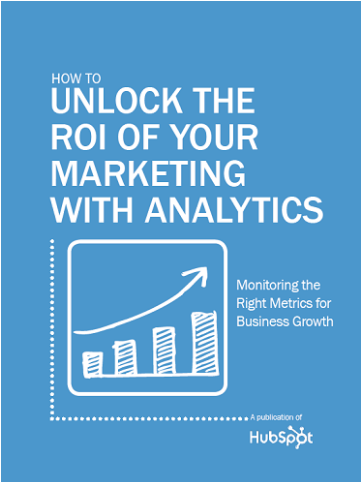But I’ve seen a lot of nurture campaigns in my work. And if I’m being honest? Most aren’t great. For instance:
- Some lean so hard on automation that they forget content matters.
- Others move too fast, or way too slow.
- I’ve seen emails with no call-to-action (CTA) at all, just a wall of copy, talking at the recipient.
- I’ve seen sequences that push a free trial before I even know what the product does.
- And I’ve been sent a second free trial offer… right as my first trial is ending, when what I really wanted was a way to talk to a sales rep.
A great lead nurturing program isn’t just about sending the right message at the right time — it’s about sending the right message, at the right time, to the right person, with the right next step baked in.
It takes smart content. Clear strategy. And yes, it takes some testing, too.
To help, I’ve broken down my best practices for writing lead nurturing emails that actually work. We’ll cover content planning, funnel mapping, and CTA strategy.
Oh, and I’ve included a chart you can download — a kind of cheat sheet on content, channels, tactics, and more based on each stage of the lead nurture funnel.
Table of Contents
- What is a lead nurturing email?
- Lead Nurturing Email Best Practices
- How does lead nurturing work?
- Are lead nurturing emails effective?
- How to Write a Lead Nurturing Email
When done well, lead nurture emails don’t come off as sales pitches. They feel more like helpful advice from someone who gets what the recipient is going through and just happens to have a smart solution.
What is a lead nurturing campaign?
Unlike one-off promos, lead nurture emails are most effective when they work together as a cohesive series. Each message should stand on its own, but also build on what came before, answering new questions, easing fresh doubts, and gently moving the reader closer to conversion. Together, they become greater than the sum of their parts.
A good lead nurture campaign is like a thoughtful conversation; it’s not a hard sell. You’re meeting your prospect where they are in the buying journey, delivering content that’s actually useful to them at that moment. That might be educational, persuasive, reassuring, or even just a well-timed nudge.

The Advantages of Lead Nurturing Emails
- Marketers are 6x more likely to get a click-through from an email campaign than from social media.
- Email ROI is high. For every $1 brands spend on email marketing, they make $36–$45.
- In 2024, automated emails accounted for 37% of email sales.
- Nearly 50% of consumers made a purchase directly from email in the past year.
- Lead-nurturing emails get 4-10x more responses than generic email blasts.
- Nurtured leads make purchases up to 23% faster.
- Companies that excel at lead nurturing are shown to generate 50% more sales-ready leads at over 30% lower cost.
How does lead nurturing work?
Lead nurturing works by building relationships with your prospects over time, not just bombarding them with discounts and/or “buy now” messages.
It’s a slow-cook strategy, ideal for high-ticket or complex offerings where a single email won’t cut it. You’re not just selling a product; you’re making a case. That means showing the value, answering the unspoken questions, and offering reassurance at every step.
Think of the lead nurturing process as walking someone through the sales funnel. At the top, they’re curious. In the middle, they’re comparing options. At the bottom, they’re almost convinced, but they still need a reason to choose your product or service. A good nurture sequence aligns with those stages, delivering content that educates, persuades, and overcomes barriers to the sale.
Lead nurturing is especially effective when:
- Your sales cycle is long.
- Your offering is significantly different from the competition.
- You’re launching something new and unfamiliar (think: the first personal computer or mobile phone; no one knew why they needed one yet!).
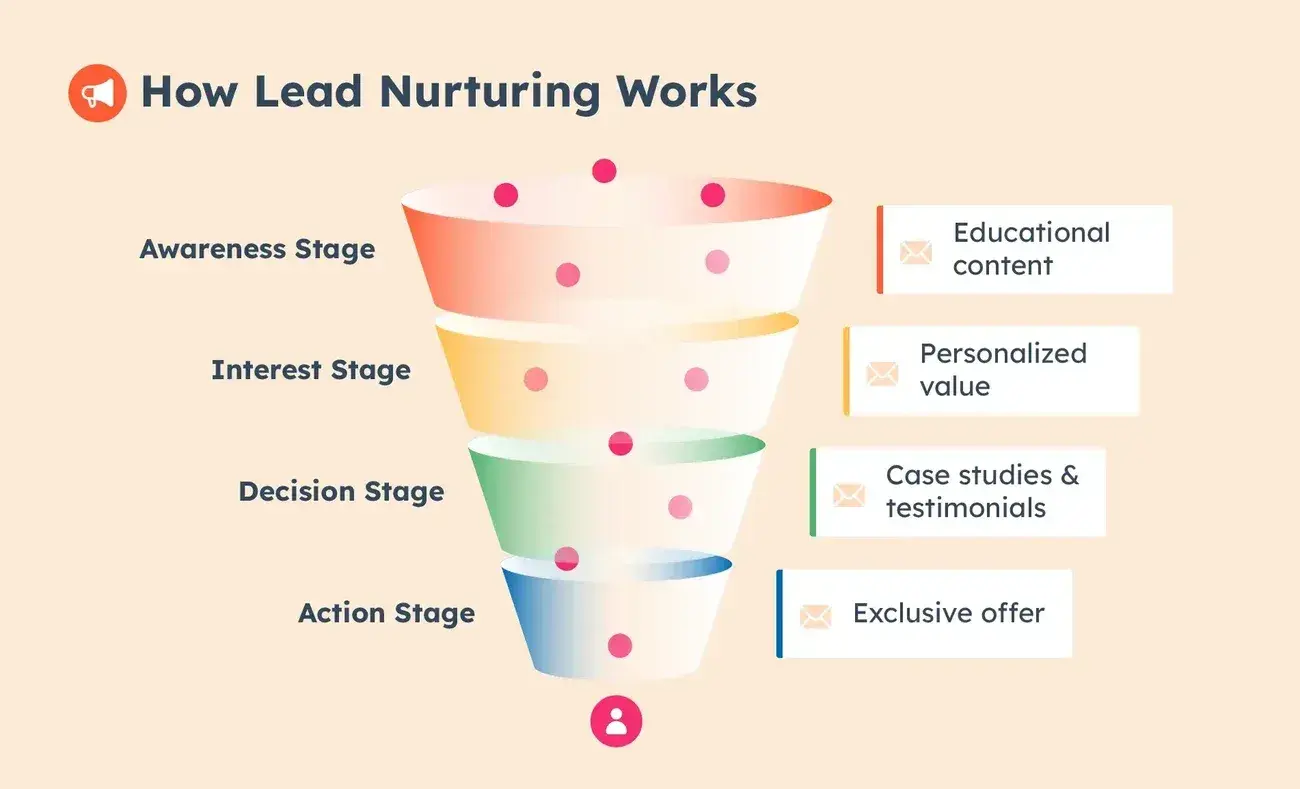
Paul Stainton, director of content and SEO at AgencyAnalytics, thinks of lead nurturing emails as “strategic touchpoints to engage prospects and remind them why they connected with your brand in the first place… Attention spans are short, and it’s easy for potential leads to forget why they initially showed interest in your company.”
In short, nurturing works because it replaces pressure with persuasion, giving people the clarity and confidence they need to say yes.
Are lead nurturing emails effective?
Short answer? Yes, but only if you do them right.
Lead nurturing emails can be wildly effective. But they’re not magic. It all comes down to relevance — relevance to the audience, to where they are in the decision-making process, and to what they actually care about.
Send the right message at the right time? You’ll build trust, move people closer to a purchase, and keep them engaged. Miss the mark (like pushing a hard sell before the lead is ready, or sending vague, generic content) and your emails will land with a thud (or worse, a one-click unsubscribe — or even worse, a spam complaint).
Nurture emails have to earn every open. If what you’re sending doesn’t feel useful, interesting, or specific to the reader’s needs, they’ll stop reading long before you get to the call-to-action. And then the likelihood of their opening your next message decreases.
So yes, lead nurturing emails can work. But only when the content is strong, the audience is clearly defined, and the messaging is mapped to where they are in the funnel.
What is a lead nurturing email sequence?
A lead nurturing email sequence is a series of emails that are automatically triggered when the lead takes a certain action. For example, once a customer adds an item to their cart, a lead nurturing email sequence could include a purchase reminder, a limited-time offer, or a list of similar products they may like.
I’ve found that the more segmenting and personalization you can add to a lead-nurturing email campaign, the better it will perform and the more conversions you’ll get.
If you want your lead nurture campaign to do more than just fill space in the inbox, here are the essential best practices I recommend, based on my own real-world experience and (plenty of) testing.
Before we dive in: Here’s a visual reference you might want to print (or at least download). It maps funnel stages to the right goals, content, and channels. Think of it as your lead nurturing cheat sheet.
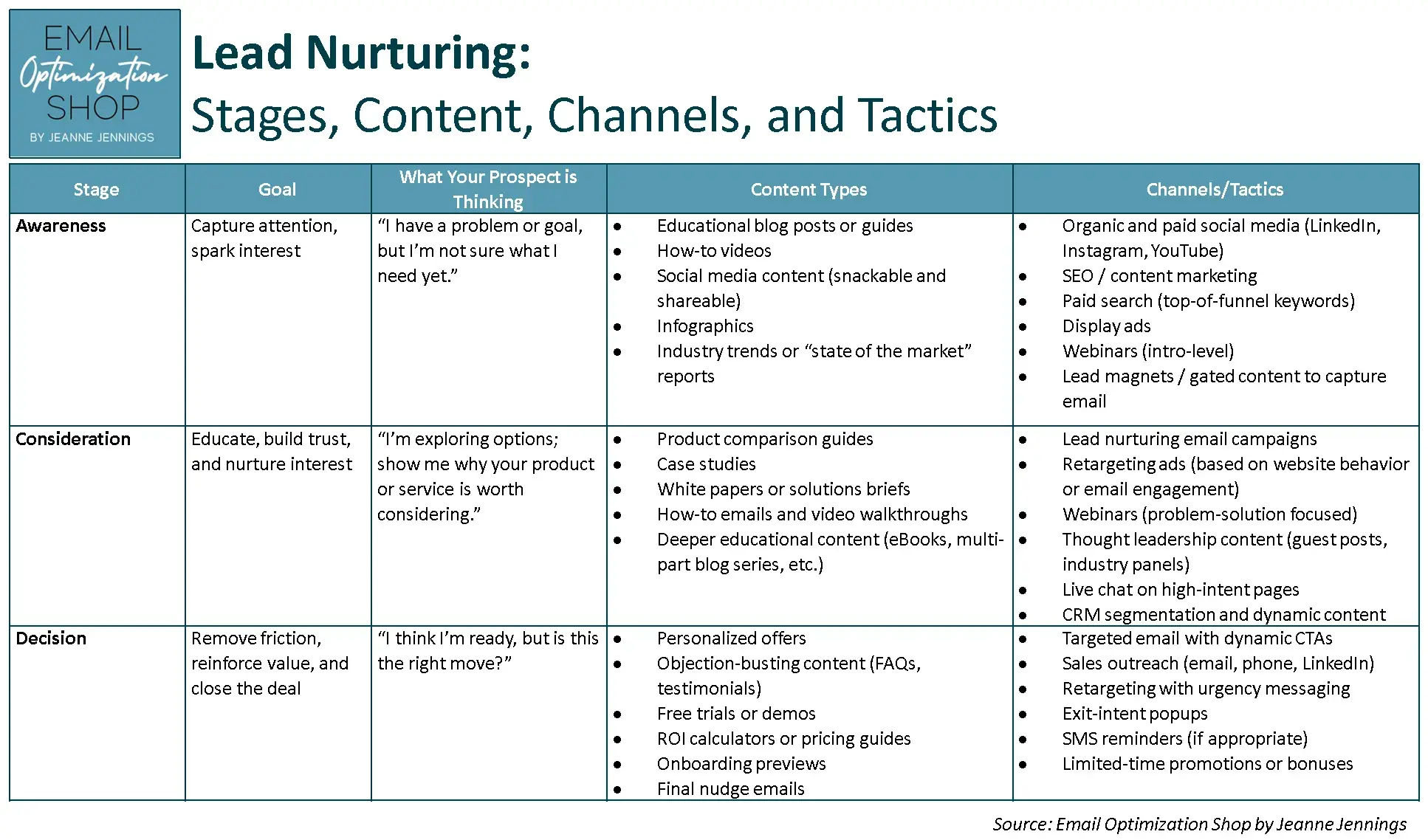
1. Match your content to the appropriate funnel stage.
Don’t send “request a demo” CTAs to someone who just learned your product exists. Each stage of the funnel (Awareness, Consideration, Decision) needs content that meets the prospect where they are. Lead nurturing isn’t about broadcasting; it’s about sequencing the right message at the right time.
2. Nurture campaigns are email-first, but not email-only.
Yes, email is the backbone of most nurturing campaigns (and the most cost-effective), but supporting channels matter. Retargeting, social media, and even live chat can all reinforce the same messages and keep your brand top of mind across platforms. Multichannel doesn’t mean chaotic; it means coordinated.
3. Use a message map to define your content strategy.
Before you write a single subject line, map your core message, supporting points, and proof to each stage of the funnel. This helps prevent redundancy, reveals content gaps, and ensures every email has a clear purpose. (Need help with this? Check out 6 Tips for Building an Effective Message Map for Your Email Campaign.)
4. Include a CTA that moves them forward in every email.
Every email in your nurture sequence should have a clear, relevant action the reader can take, even if they’re not ready to talk to sales. Think: download a deeper-dive resource, register for a webinar, or explore a product comparison guide. These micro-CTAs are about momentum, helping your lead take the next natural step toward the decision point.
You’re not rushing the sale. You’re lighting the path.
5. Include the final CTA in every message, so they can convert when they’re ready.
While you’re pacing out your nurture content, remember: Not everyone follows your timeline. Some people will be ready to buy on email #1. Others might take five. That’s why every message in your series should also include a subtle but accessible link to the final conversion action, whether that’s “Talk to Sales,” “Start a Free Trial,” or “Schedule a Demo.”
Think of it as a side door out of the funnel. You’re giving your leads control, not forcing them to wait for a magic moment.
6. Follow best practices in email design.
Your message might be brilliant, but if it’s hard to read or looks broken on mobile, it won’t matter. Use a meaningful “from” address. Focus your copy on what’s in it for your readers. Use bulletproof buttons in your emails — not text links. Use alt text on images. (More on all this in 16 best practices for email design, according to an email marketing consultant.)
7. Track the right KPIs.
Don’t judge your nurture campaign’s success or failure by click-through rate. This can be misleading. I wrote about this in Proof That Click-through Rate Is Not a Good KPI.
Instead, look at a metric that actually reflects performance. For lead nurture campaigns, this is typically some version of conversion rate.
Conversion rate tells you whether the email is doing its job; conversion doesn’t have to mean “sale.” A conversion might be a page view, a download, or any action that moves the prospect further down the funnel.
Over time, you want to look at how the entire series performs: which messages drive momentum, which ones stall it, and how long it typically takes someone to convert. If a message isn’t pulling its weight, revisit your message map and test smarter next time.
8. Don’t set it and forget it — test!
Automation isn’t an excuse to set it and forget it; it’s an opportunity to test, refine, and improve. Once your nurture campaign is running, use the time you’ve saved to A/B test subject lines, CTA placement, send cadence, and even the order of your messages.
Often, small tweaks, like rearranging the email sequence or tightening the CTA copy, can deliver big increases in conversions and bottom-line performance. Don’t guess; test.
How to Write a Lead Nurturing Email
Writing a lead nurturing email is about using strategy and structure to move your reader forward. Here’s how I build them, based on what’s worked across hundreds of client campaigns and tested experiments.
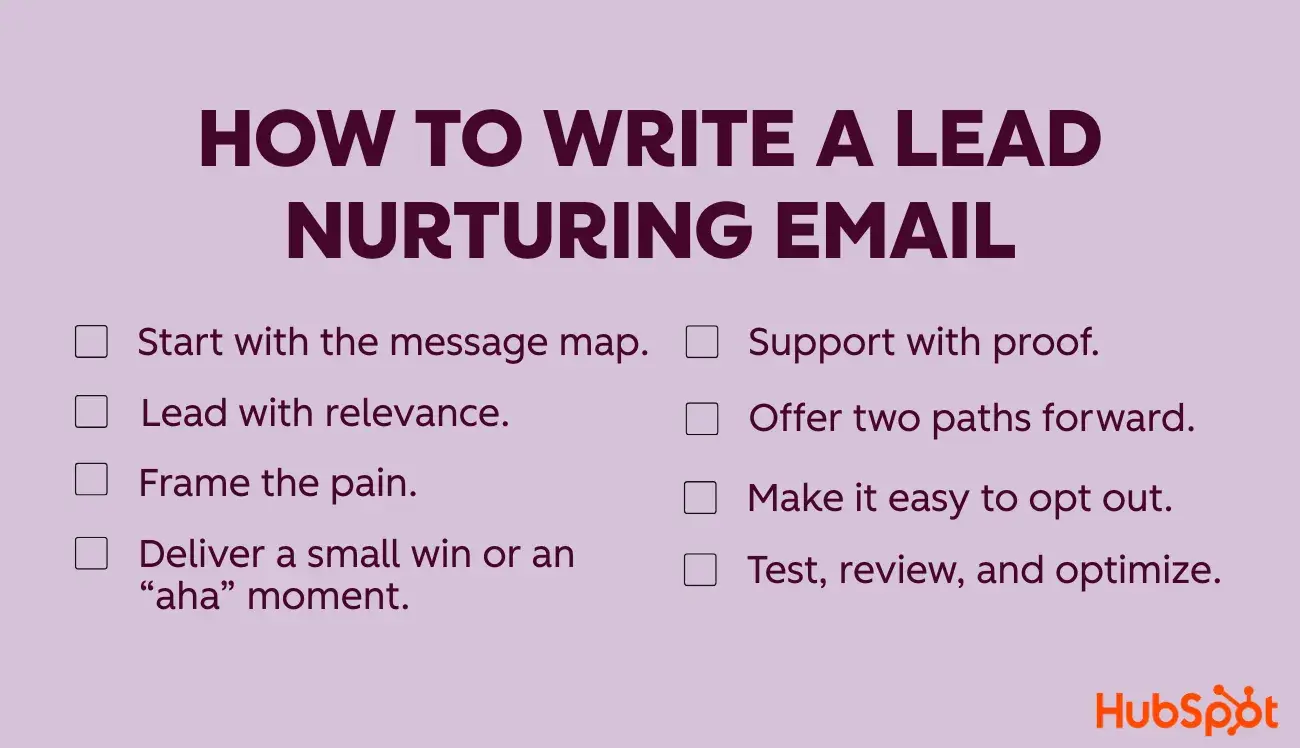
1. Start with the message map.
Before you write a single word, be clear about what this email is supposed to do within the larger series. What funnel stage are we targeting: awareness, consideration, or decision? What’s the key message here? How does it build on the last email, and what comes next?
Pro tip: A message map helps ensure each email has a job to do, and keeps you from repeating yourself or skipping critical steps.
2. Lead with relevance.
The inbox is noisy. If your friendly from address, subject line, preheader text, and opening sentence don’t immediately connect to something the reader cares about, you’re done.
Use segmentation to tailor your message, by industry, pain point, stage in the journey, or behavior. This isn’t “Dear {First Name},” personalization, this is relevance that earns the open and keeps them reading.
For example, if a lead visits my pricing page multiple times but doesn't convert, I might trigger a special welcome email sequence that highlights customer success stories and offers a limited-time discount.
3. Frame the pain.
Every good lead nurturing email starts with a problem, not a pitch. Show your reader that you understand what’s hard, what’s frustrating, or what’s holding them back. When you articulate their pain better than they can, they’ll trust you to solve it.
4. Deliver a small win or an “aha” moment.
Even if the email doesn’t convert, it should still deliver value. Share something they didn’t know, or didn’t see from that angle before: a data point, an insight, a useful tip. I call these “knowledge bombs.” They build credibility and reframe the reader’s thinking in your direction.
Bonus: These are also the bits that get forwarded.
5. Support with proof.
You’re not just saying you can help, you’re showing it. Depending on the funnel stage, this could be a testimonial, a stat from a case study, or even a client quote embedded in the copy. Social proof isn’t just for the bottom of the funnel; it builds trust throughout.
6. Offer two paths forward: micro-CTA + conversion CTA.
Every email should give the reader a way to take the next step (read a guide, watch a video, reply with a question) and a way to jump ahead if they’re ready (book a call, start a trial). Not everyone follows your funnel timeline. Let them self-select.
7. Make it easy to opt out.
Letting people unsubscribe doesn’t hurt your list, it strengthens it. If someone’s not interested, let them go. You’ll boost deliverability, protect your sender reputation, and focus on the people who are leaning in.
8. Test, review, and optimize.
Your nurture sequence is never truly “done.” Track real performance metrics (conversion rate, click-to-open, time to conversion), not just opens and CTR. If an email isn’t pulling its weight, rewrite it. If your CTA isn’t getting clicks, test a new one. The goal isn’t perfection but to always be progressing.
Make your nurture program worth the clicks.
If you’ve made it this far, you already know: Lead nurturing isn’t just about automation. It’s about strategy, message mapping, timing, and above all, relevance.
It’s one of the things email does best. But only when every piece of the program is working together: the right message, delivered at the right time, with a clear path forward. Miss any one of those and you risk losing your lead right when you’ve got their attention.
So whether you’re building a nurture program from scratch or giving your current one a much-needed audit, don’t just focus on the tech. Look at the message, the pacing, the CTAs, and the gaps.
And then test. Because the best-performing nurture programs aren’t perfect, they’re continually improving.
Editor's note: This post was originally published in June 2024 and has been updated for comprehensiveness.
Lead Nurturing

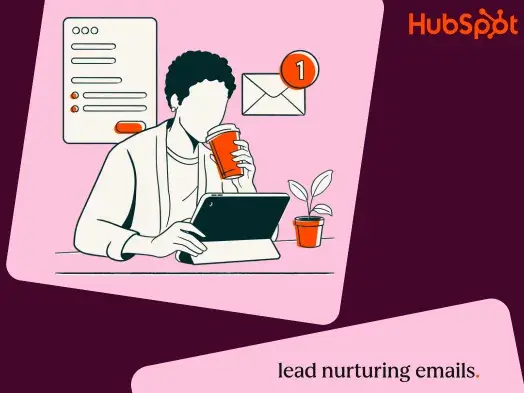
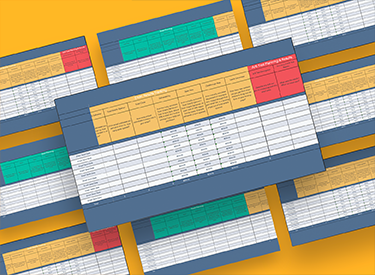


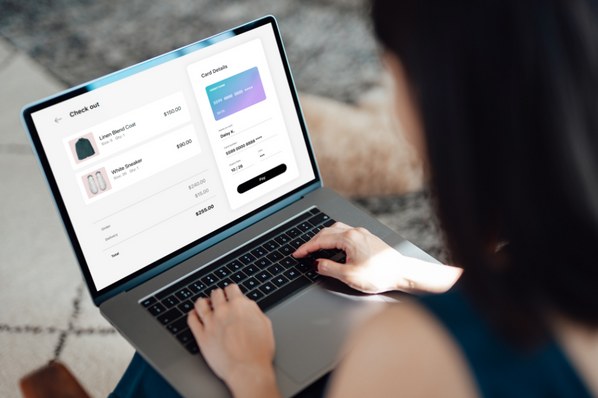




![How to Expand Your Lead Nurturing Strategy Beyond Just Email [SlideShare]](https://53.fs1.hubspotusercontent-na1.net/hub/53/file-1390659247-jpg/Blog_Thinkstock_Images/lead_nurturing.jpg)

